Benthic foraminiferal assemblages from the Safranbolu Formation(Cuisian,Eocene),Northwest Anatolia,Turkey
Kubra Okurand Hatice Kutluk
Abstract Twenty-one outcrop samples collected from a 28-m-thick section from the Safranbolu Formation of the southwestern part of the Safranbolu Basin, Anatolia, Turkey yielded well-preserved benthic foraminifera belonging mainly to the genera Alveolina, Nummulites, Assilina, Rotalia, Disclocyclina and Orbitolites. Alveolina is the most diversified genus that is represented by sixteen species: Alveolina archiaci, A. axiampla, A. barattoloi, A. carantana, A.colatiensis, A. cuspidata, A. distefanoi, A. histrica, A. lehneri, A. oblonga, A. polatliensis, A. rakoveci gueroli, A. ruetimeyeri,A. rugosa, A. safranboluensis and A. sirelii. Alveolina safranboluensis and A. sirelii are described new. Comparison of the fossil assemblage with those assemblages previously reported from both Turkey and other Tethyan sub-basins revealed that the deposition occurred during the Cuisian (Eocene) and corresponded to Shallow Benthic Foraminiferal Zones (SBFZ) 10–12. The abundance and diversity of the larger benthic foraminifera indicated that the Safranbolu Formation was deposited under transgressive conditions.
Keywords: Eocene, Cuisian, Safranbolu Formation, Benthic foraminifera, Alveolina, Northwest Anatolia
1 Introduction
The temperature-sensitive,larger benthic foraminifera were among the most common microfossils in the Tethyan region and have been used successfully as index markers in establishing the marine stages of the late Paleocene–middle Eocene period. The shallow marginal areas of the subbasins circumscribing the Tethys Ocean which are composed mainly of carbonates and sometimes intercalated with terrigenous material, hosting rich and diverse assemblages of benthic foraminifera from the Atlantic Coast to the Indo-Pacific Ocean.The late Paleocene–middle Eocene period which is also known as the warmest period of all the Cenozoic Era with its rapid and pronounced temperature increases (e.g. Rea et al. 1990; Fricke and Wing 2004;Higgins and Schrag 2006; Lowenstein and Demicco 2006;Nicolo et al.2007;Sexton et al.2011;Foster et al.2013)is a distinctive period in diversification and abundance of larger benthic foraminifera,belonging mainly to the genera Alveolina,Orbitolites,Nummulites and Assilina.
Benthic foraminiferal assemblages of the Thanetian–early Lutetian Safranbolu Formation were investigated in this study and compared with previously studied assemblages both in Turkey (Sirel 1976,1992, 1998,2000;Sirel and Gündüz 1976; Av?ar 1992; ?zgen 1998; ?nan and ?nan 1999; ?zgen-Erdem 2002; Din?er and Av?ar 2004;?zgen-Erdem et al. 2005; ?zcan et al. 2007; Sirel and Acar 2008; ?zce et al. 2013) and in the Tethyan realm(Drobne et al. 2011; Molina et al. 2003; and references therein). Micropalaeontological investigations revealed that the Safranbolu Formation comprised a prolific assemblage of Alveolina species together with the genera Nummulites, Assilina, Discocyclina, Orbitolites and Rotalia. Alveolins, with their short stratigraphic range of the upper Paleocene–middle Eocene and wide geographical distribution around the entire Tethyan region, have been effectively used as index fossils in the assessment of palaeoenvironments and in solving biostratigraphical problems (Serra-Kiel et al. 1998; Sirel 1998; Din?er and Av?ar 2004; ?zgen-Erdem et al. 2007; Sirel and Acar 2008; Drobne et al. 2011). The members of the genus were also important sediment contributors to shallowwater carbonate platforms (Sirel 1998; Sirel and Acar 2008; Drobne et al. 2011). Their diversification at specific level,adaptation to a variety of ecological settings and occurrence in a wide range of habitats from deep lagoons to fore-reef settings make them a significant group of fossils of the Paleogene strata (Drobne et al. 2011). Alveolinids are among the most common microfossil group of larger benthic foraminera in Turkey too,and were reported from several carbonate-rich basins, such as Manisa, Tav?anl?-Kütahya, Seyitgazi and Hank?y-Eski?ehir, Orhaniye, Polatl? and Haymana-Ankara, ?ark??la-Sivas, ?arlakdere and ?amard?-Ni?de,Karaman,Namrun-??el,Darende-Malatya(Sirel 1976, 1998; Av?ar 1992; ?zgen 1998; ?nan and ?nan 1999; Din?er and Av?ar 2004; ?zgen-Erdem et al. 2005,2007;Sirel and Acar 2008;?zce et al.2013).Drobne et al.(2011) in their study of the Paleogene Adriatic Platform,reviewed the spatial and stratigraphic distribution of alveolinids of the shallow zones of Tethyan margins from Spain,France,Italy,Greece,Turkey,Libya,Egypt,Somalia,Tanzania, Iran, Iraq, Lebanon, Palestine, Pakistan to the Persian Gulf. The aforementioned occurrences of alveolinids were inferred here for the comparisons of the taxa found in the Safranbolu Formation. The assemblage is expected to contribute to the understanding of the marine stages of the Tethyan region and elucidate palaeoenvironments of the early Eocene period.
2 Geological setting
The Safranbolu Basin (Fig. 1) is located in the western part of the North Anatolian Orogenic Belt, also referred to as the Pontides, which extends from the Rhodope Mountains in the Balkans in the West to the Caucasus in the East (Fig. 2; G?rür and Tüysüz 2001). This belt is represented mainly by three units in Turkey: the Strandja Zone, the ?stanbul Zone, and the Sakarya Continent (Fig. 2). All these three units display an affinity to belonging to the southern margin of the Laurasian Continent (G?rür and Tüysüz 2001). The Safranbolu Basin was formed in the southeastern part of the ?stanbul Zone (Fig.2).
Palaeotectonic units that formed the landmass of modern Turkey were separated by the seaways of the Tethys Ocean during the Mesozoic (Y?lmaz et al. 1997; Bozkurt and Mittwede 2001; G?rür and Tüysüz 2001; Okay 2008; Moix et al. 2008). The commencement of the Alpide orogeny by the subduction of the Tethyan ocean floor beneath Laurasia resulted in progressive closure of the seaways between these units during the time span from the Late Triassic to the Eocene. The Pontides were the first tectonic unit that began to rise as a volcanic island-arc in an E–W direction as a result of the convergence of Gondwana towards Laurasia. While the Black Sea started to open as a marginal back-arc basin in the north,fore-arc basins were formed in the southern flanks.The formation of the magmatic arc and superimposed accretionary complexes consequently led to the development of arc-related sedimentary basins on an imbricated topography during the course of the subduction (Y?lmaz et al. 1997; G?rür and Tüysüz 2001; Okay 2008). The Safranbolu Basin is one of those arc-related basins in the southeastern part of the Western Pontides(Fig.2).Besides the Safranbolu, several basins generated in this way along the southern flanks are now present in the suture zone(Saner 1980;Saner et al.1980).
The geology of the Safranbolu Basin has a long history of study (e.g. Uysal 1959; Canik 1977; Saner 1980; Saner et al.1980;Kaya and Dizer 1982;Sezen 1983;?ztürk et al.1984;Keskin 2017).The Mesozoic units were unconformably overlain by the Safranbolu Formation (Saner 1980)(Fig. 3). The Safranbolu Formation in the northern part was underlain in part by the Ulus Formation and in the southern part by the K??lak?y Formation,both of the Early Cretaceous age(Timur and Aksay 2002).
Flysch facies of turbiditic sandstone and shale of the Ulus and K??lak?y Formations terminated with sandstone and conglomerate indicate the emergence of the Safranbolu Basin at the end of the Early Cretaceous(Saner et al. 1980; Ko?yi?it 1987; Keskin 2017). A new depositional phase by the subsidence of the basin is inferred from calcareous sandstone after a long erosional period starting from the end of the Early Cretaceous until the early Paleocene (Thanetian). The early Paleocene calcareous sandstone was overlain by carbonates of the early Eocene age(Ilerdian),and laterally graded into argillaceous limestone of the Safranbolu Formation during the Cuisian with an influx of terrigenous material. The early Eocene(Ilerdian and Cuisian)sediments,therefore,can be ascribed as representing a shallow-marine shelf setting having fluvial influence. The deposition in the Safranbolu Formation completed with marls during the middle Eocene (Lutetian) which is conformably overlain by siltstone, sandstone and conglomerates of the Karabük Formation.
The Safranbolu Formation as a whole is characterised by a limestone-dominated lithology and is often called as‘Safranbolu Limestone’ in the literature (Saner 1980). Limestone is of nodular type in the study area. A late Paleocene–middle Eocene age was assigned to the Safranbolu Formation based on stratigraphical relationships (Saner et al. 1980), and it was regarded as contemporaneous with the‘Evri Limestone’,the ‘A??l?k Formation’ of Kaya and Dizer (1982) and the‘Sazlar Formation’ of Cerit (1983) of the neighbouring basins. Saner et al. (1980) pointed out the presence of reefal carbonates in limited areas of the east-west trending southern border of the Safranbolu Basin, presumably of fringe type since they were outcropped along the coastal borders of the basin.
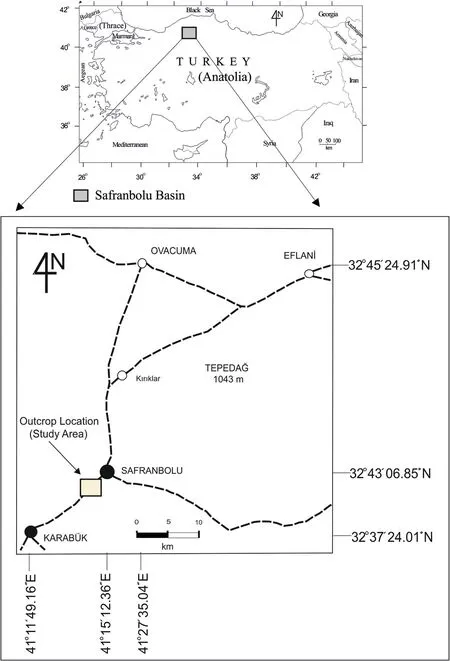
Fig.1 Geographic map of the study area in the Safranbolu Basin,Turkey
Continued rise of the North Anatolian Mountains in the north, as a consequence of the N–S compressional forces that have been active in the region since the Late Triassic, formed an intermontane character of the Safranbolu Basin during the middle–late Eocene, and,led to the terminal closure of the basin during the late Eocene. The basin gained a molasse character with further filling of terrigenous sediments during the Oligocene and finally became an erosional area during the Neogene (Saner 1980; Saner et al. 1980; Timur and Aksay 2002). Besides, the N–S compressional forces resulted in the generation of a series of thrust faults in the region during the Eocene (Ko?yi?it 1987).
3 Material and method
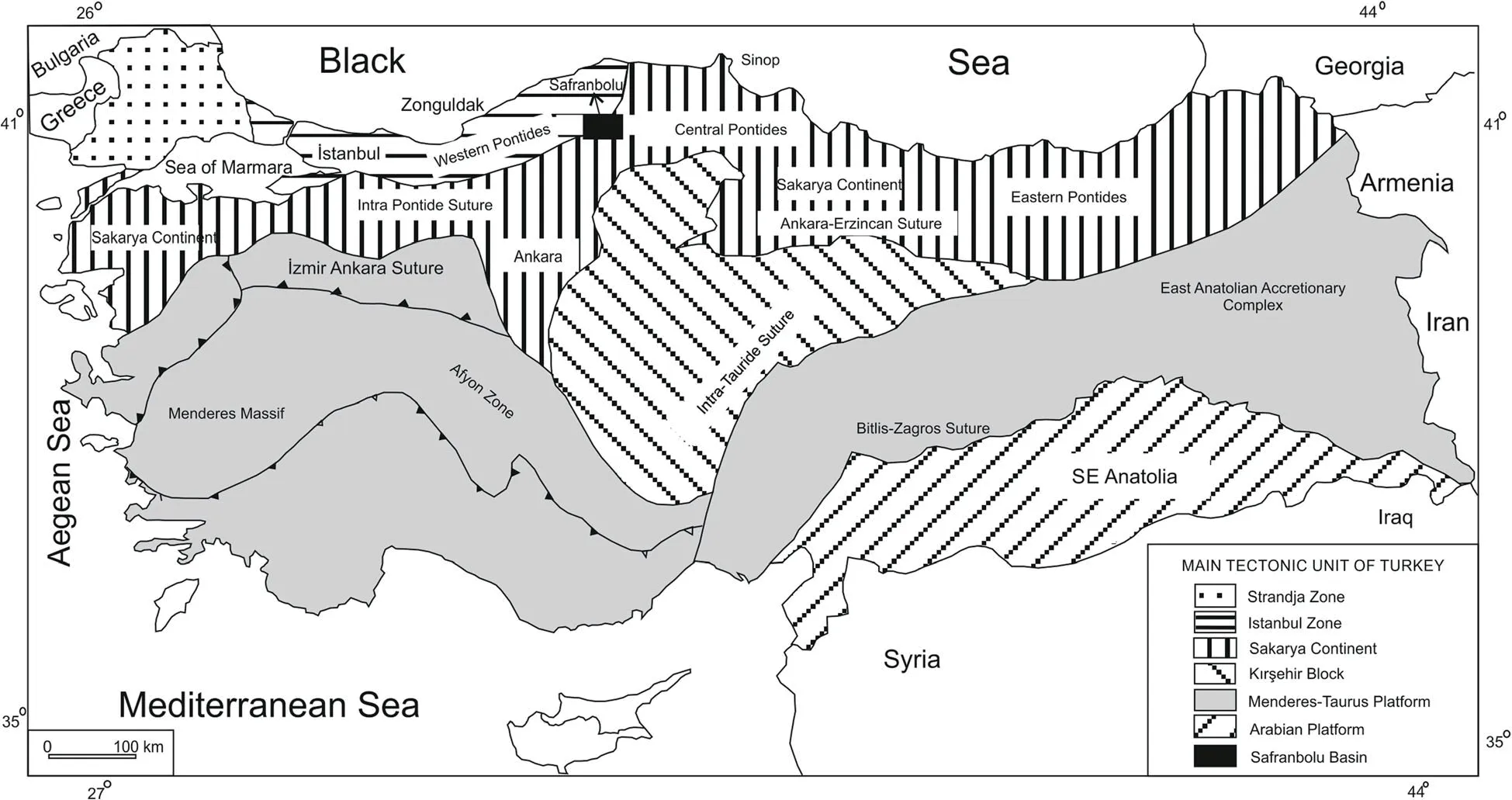
Fig.2 Map showing major tectonic units of Turkey(after G?rür and Tüysüz 2001)
The Safranbolu Basin is a NE–SW trending funnel-shaped basin,with a width of 2–2.5 km in the west and 30–35 km in the east. The Early Cretaceous Ulus/K??lak?y Formations and the early Eocene (Ilerdian) basal units of the Safranbolu Formation were not outcropped in the study area;and,the middle Eocene(Lutetian)marly layers of the Safranbolu Formation and the middle–late Eocene Karabük Formation were eroded away in the study area. The outcropped part of the Safranbolu Formation, however,has been observed in the southeastern sector of the study area across the valley during the field work, as shown in Fig. 4. The total thickness of the Safranbolu Formation attains up to ~300 m (?zgen-Erdem et al. 2005), and the exposed segment of the formation in the study area displays ~28 m thickness. Changes in thickness may be caused by the variations in palaeotopography on which the formation deposited.
The sampling was conducted in the section exposed at the southwestern sector (Fig. 4) of the Safranbolu Basin since the steep scarp of argillaceous limestone outcropped in the southeastern sector prevented the sampling, and were started from the upper part of 28-m-thick sequence.21 outcrop samples were collected from three intervals,following fossiliferous levels, for this study (Figs. 4 and 5).Seven samples (Nos. 1–7) were collected from the first ~9 m interval from the top,seven samples(Nos.8–14)were from the next 8 m interval in the middle,and samples 15–21 were from the 11-m-thick bottom-interval of the total 28-m-thick section (Figs. 4 and 5). Seven among all these samples, mostly taken from the weathered and pulverized lithology, were barren of fossils (Table 1). Whole-rock hand-specimens from the rest 14 fossiliferous samples were prepared to obtain 250 oriented and random thin sections for the microscope study. Isolated grain specimens of some Alveolina,Nummulites,Orbitolites,Rotalia,and Assilina were also picked up for taxonomic analyses.Specimens were analysed under Carl Zeiss Axio Scope,Zeiss Imager M1 and Leica microscopes and were stored in the collection of Micropalaeontology laboratory of the Department of Geology,Eski?ehir Osmangazi University.
Aforementioned occurrences of fossils both in Anatolia and other Tethyan sub-basins were inferred for determining the age and depostional environment of the Safranbolu Formation.The scheme of platform and pelagic marine zonation of Serra-Kiel et al. (1998) (Shallow Benthic Foraminiferal Zones, SBFZ) were utilised for the zonation. Alveolinid species encountered in the Safranbolu Formation, in Anatolia,and in the eastern,central and western Tethys are illustrated in Fig. 6; the stratigraphical range of alveolinid species is shown in Fig. 5 and Table 2; and, the spatial distribution of alveolinid species in the study area is illustrated in Fig.7.
4 Results and discussion
4.1 Systematic palaeontology
Samples collected from the Safranbolu Basin yielded Alveolina archiaci, A. axiampla, A. barattoloi, A. carantana, A.colatiensis, A. cuspidata, A. distefanoi, A. histrica, A. lehneri,A.oblonga,A.polatliensis,A.rakoveci,A.ruetimeyeri,A. rugosa, A. safranboluensis, A. sirelii, A. aff. ruetimeyeri,A.cf.ruetimeyeri,A.cf.carantana,A.aff.Bronnimanni,A.
aff. Cremea, together with the fossils of Nummulites partschi, Assilina spp., Discocyclina spp., Orbitolites spp.,Rotalia spp., and Gastropoda. Alveolina safranboluensis and A.sirelii are herein newly described.
FORAMINIFERIDAEichwald, 1830
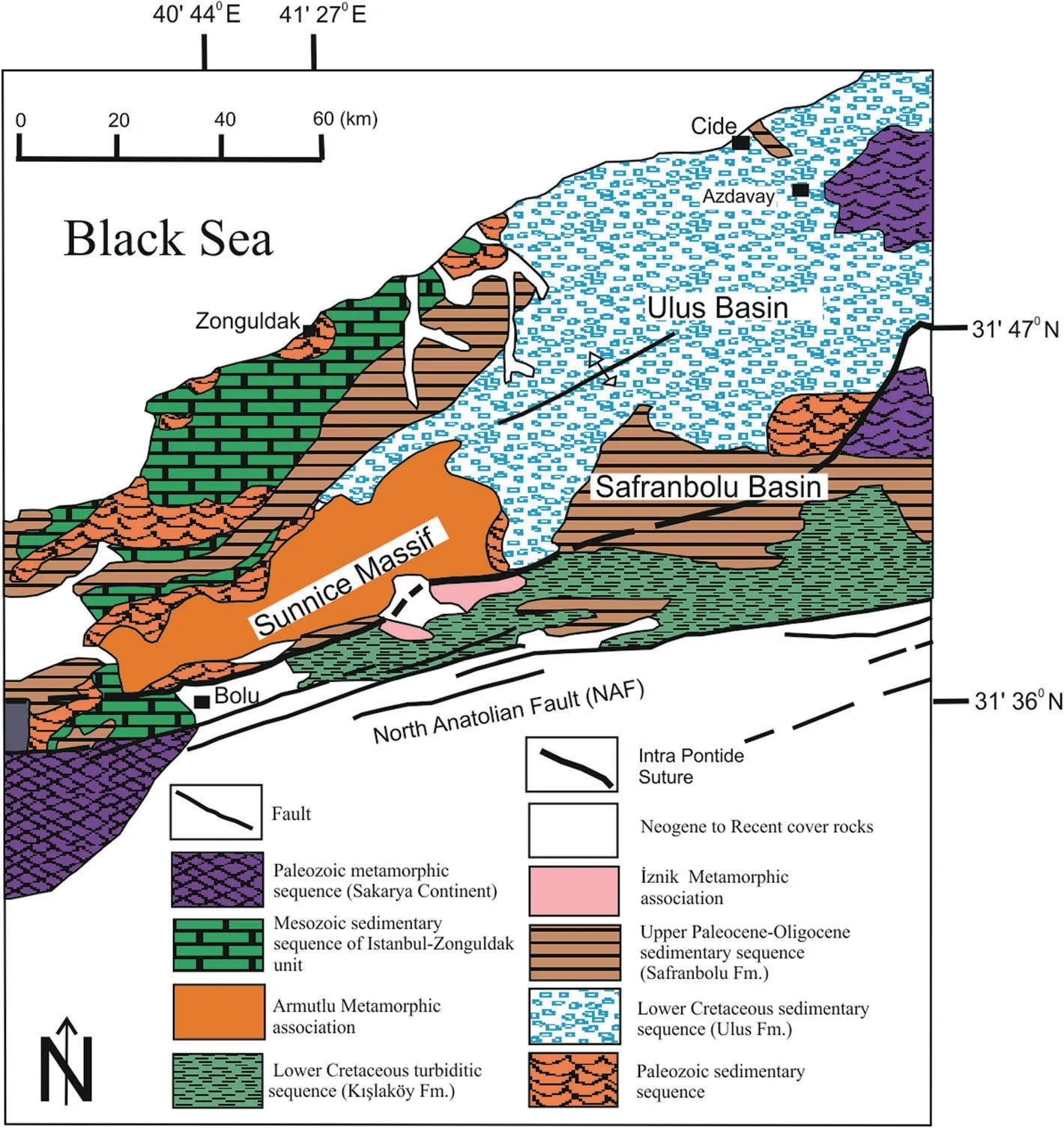
Fig.3 Geological map of the study area,Turkey(modified after Y?lmaz et al.1997 and Timur and Aksay 2002)

Fig.4 Sample locations of the study area.a – Samples 1–7:Outer shelf(A) (Lower Photic Zone)and Samples 8–14: Middle shelf(B)(Upper Photic Zone);b – Samples 8–14: (Middle shelf(B)(Upper Photic Zone)and Samples 15–21: Inner shelf(C)(Upper Photic Zone); c– Counterpart of the study site showing complete sequence of argillaceous limestone across the eroded valley, underlain by carbonates and overlain by marly layers
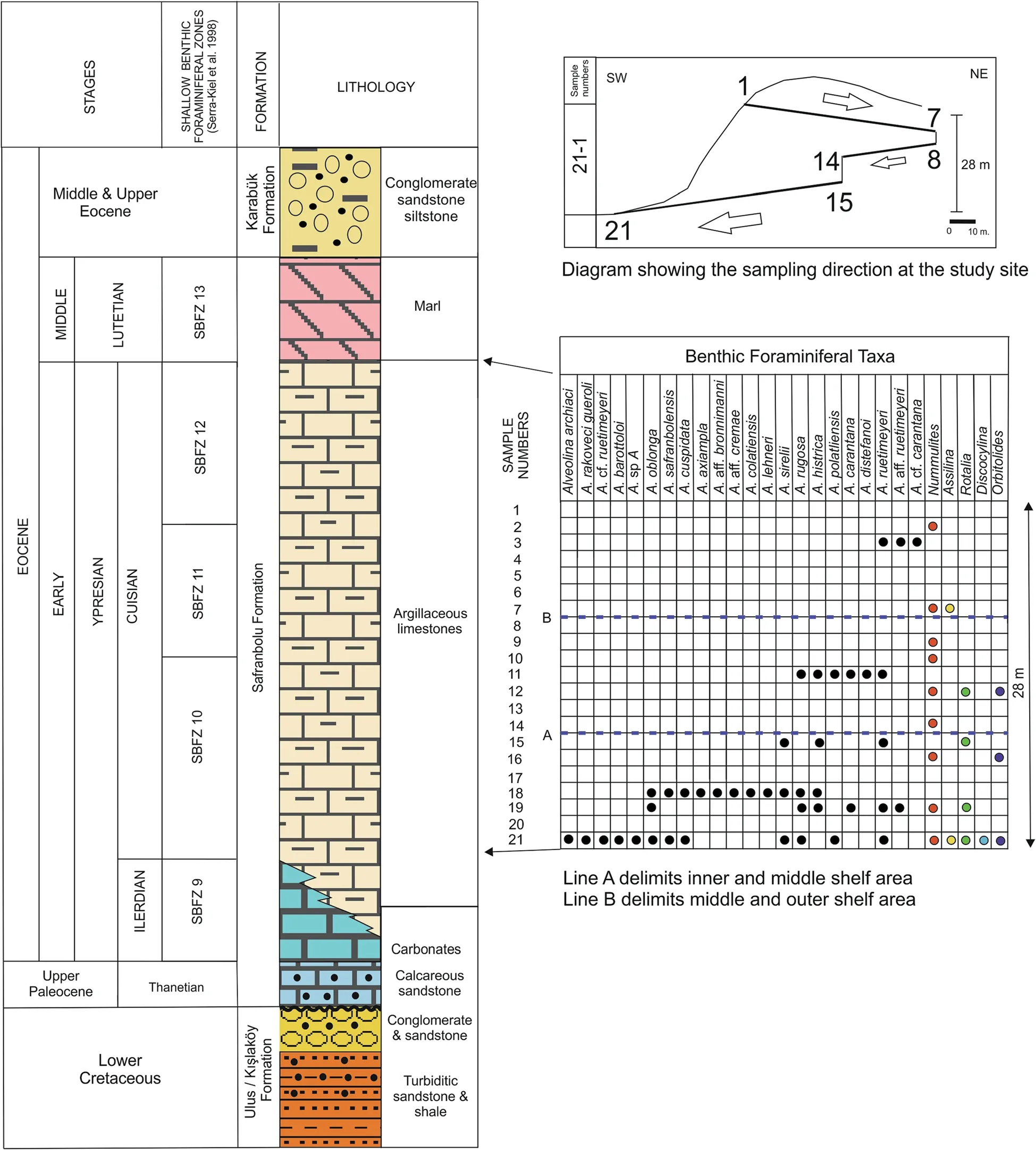
Fig.5 Stratigraphic range and biostratigraphic zonation of the alveolinid species in the Safranbolu Formation
SuperfamilyALVEOLINACEAEEhrenberg, 1839
FamilyALVEOLINIDAEEhrenberg,1839
GenusAlveolinaD’Orbigny 1826
Alveolina archiaciSirel and Acar 2008
Plate 1_1
(Slide No.: A2102; Sample No.: 21)
2008 Alveolina archiaci Sirel and Acar, p. 59, pl. 46,figs. 11–14.
Remarks:The test size of Alveolina archiaci is similar to A. barottoloi, however, A. archiaci differs from the latter by possessing a larger elongation index and smaller axial thickness hence containing more whorls. The only reportedoccurrence of A.archiaci is from the Belendiz section of the lowermost–middle Cuisian from Karaman in Turkey by Sirel and Acar(2008)(Table 2).Alveolinid species associated with this taxon in Safranbolu Basin and the Belendiz section confine its range to the SBFZ 11. Restricted occurrence of the species to Central Tethyan region only, may imply that it is an endemic species.A.archiaci is recorded in the upper photic zone in the inner shelf area close to the coast line in Safranbolu Basin with several other alveolinid species.
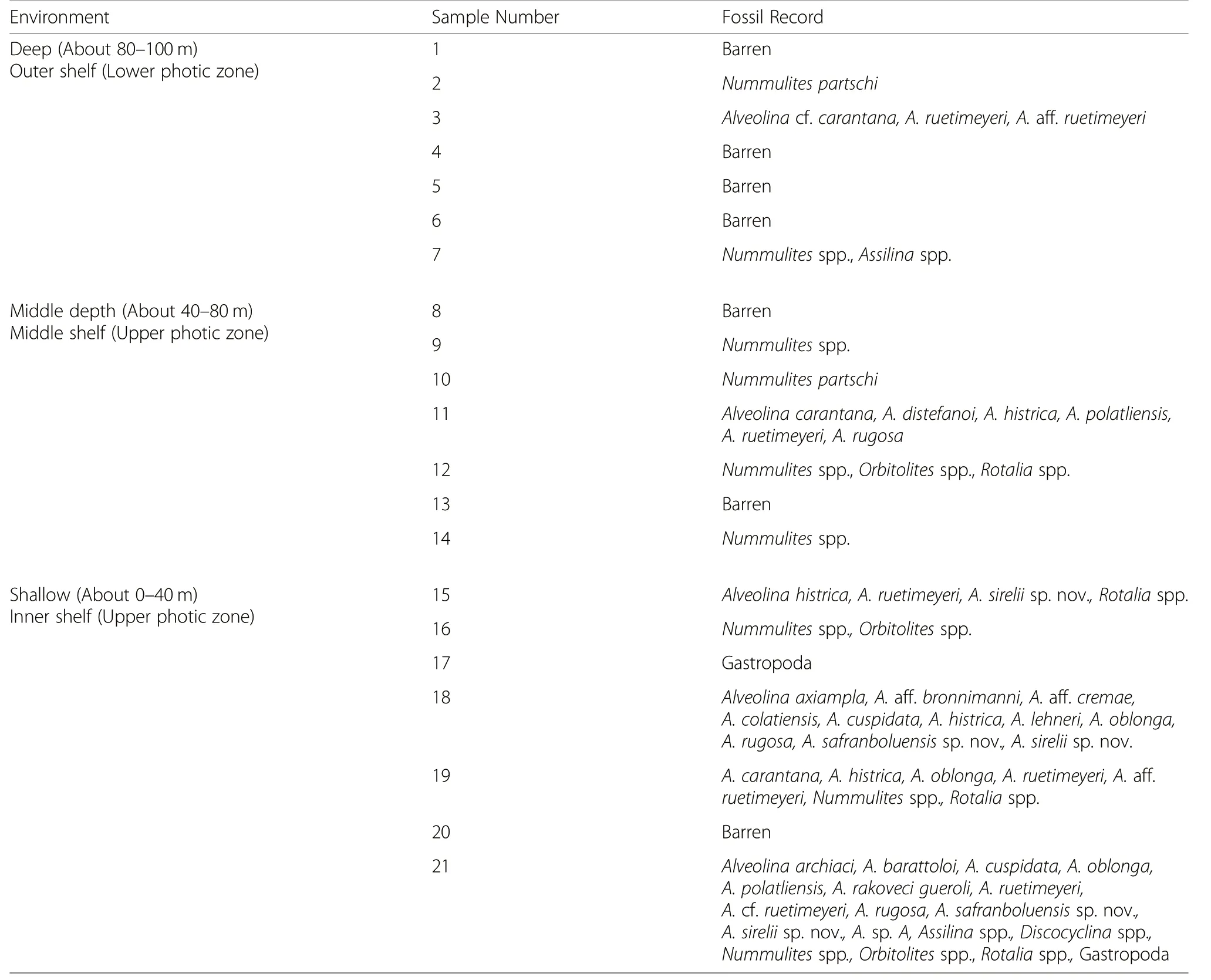
Table 1 Alveolinid species and the other benthic genera recorded in the Safranbolu Formation
Alveolina axiamplaDrobne 1977
Plate 1_2
(Slide No.: A1903; Sample No.: 19)
1977 Alveolina aff. Axiampla Drobne, p. 65, fig. 36b,pl. 17, figs. 6–9; pl. 18, figs. 1–2.
2000 Alveolina axiampla Drobne, ?no?lu, p.271.
2011 Alveolina axiampla Drobne,Drobne et al.,p.728.
Remarks:Alveolina axiampla is similar to A. ruetimeyeri and A. cylindriformis in terms of its test size.However, it is more cylindrical than A. ruetimeyeri and has larger proloculum than that of A. cylindriformis. The specimens recorded here are similar to Alveolina aff.Axiampla recorded by Drobne et al. (1977) in their length, width, elongation index and size of proloculus. A.aff. Axiampla has been recorded from the lowest Lutetian by Drobne et al. (1977) and the Cuisian by Drobne et al.(2011).The taxon has been recorded from the middle–upper Cuisian in Turkey by ?no?lu (2000). The range of the specimens corresponds to SBFZ 10 and indicates the upper photic zone.
Alveolina barattoloiSirel and Acar 2008
Plate 1_3
(Slide No.: A2105; Sample No.: 21)
2008 Alveolina barattoloi Sirel and Acar,p.46,figs.4–6.
Remarks:Alveolina barattoloi possesses the same test and proloculum size with A. archiaci adamsi, however,the latter has greater elongation index. A. barattoloi was first described by Sirel and Acar (2008) from the lower–middle Cuisian argillaceous limestone of the Sakarya section, Polatl?, SW Ankara. The range of the species corresponds to SBFZ 10 and is recorded in the upper photic zone of the lower–middle Cuisian.
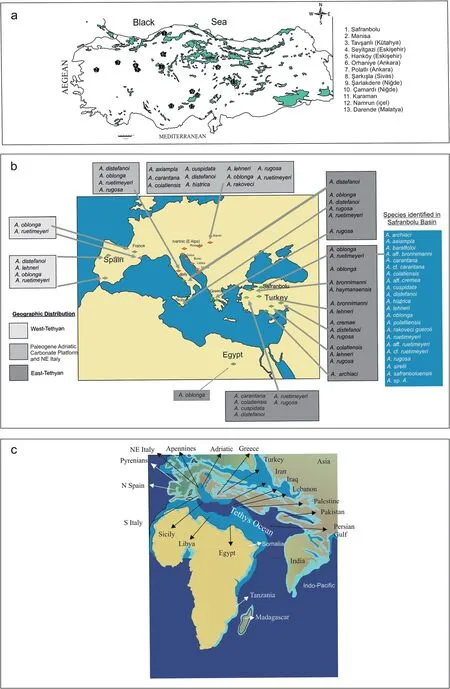
Fig. 6 a – Ypresian (Cuisian) and Lutetian Alveolina sites in Turkey (Eocene outcrops shaded); b – Alveolina sites along the Tethyan ocean margins;c –Alveolina species encountered in the Safranbolu Formation and in eastern, central and western Tethys(see text for sources)
Alveolina aff. bronnimanni
Plate 1_4
(Slide No.: A1803; Sample No.: 18)
Remarks:Alveolina aff. Bronnimanni is similar to A.bronnimanni Sirel and Acar 2008 in its growth stage and the thickness of the basal layer; however it possesses a larger size and elongation index.
Alveolina carantanaDrobne, Pavlovec & Drobne 1977
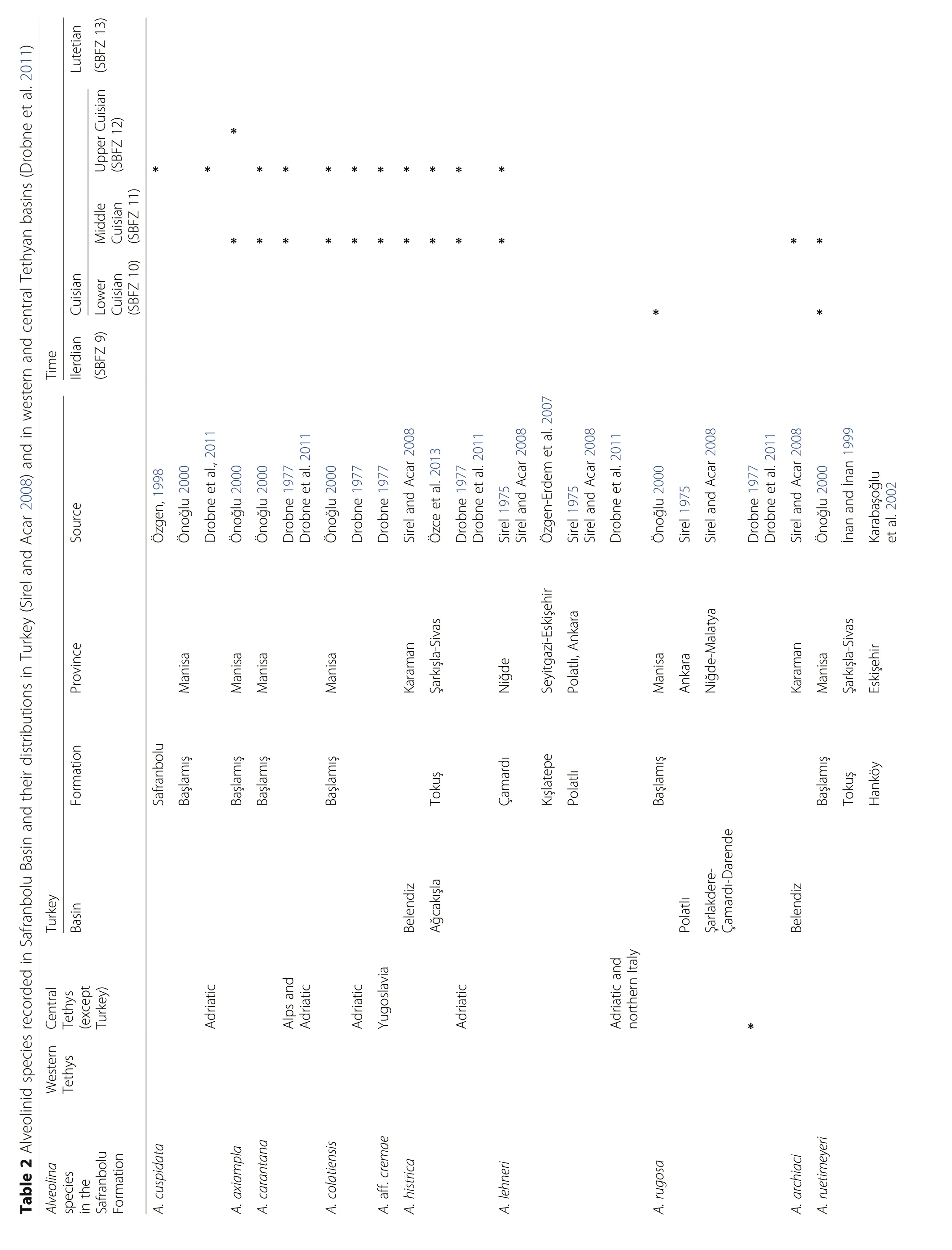
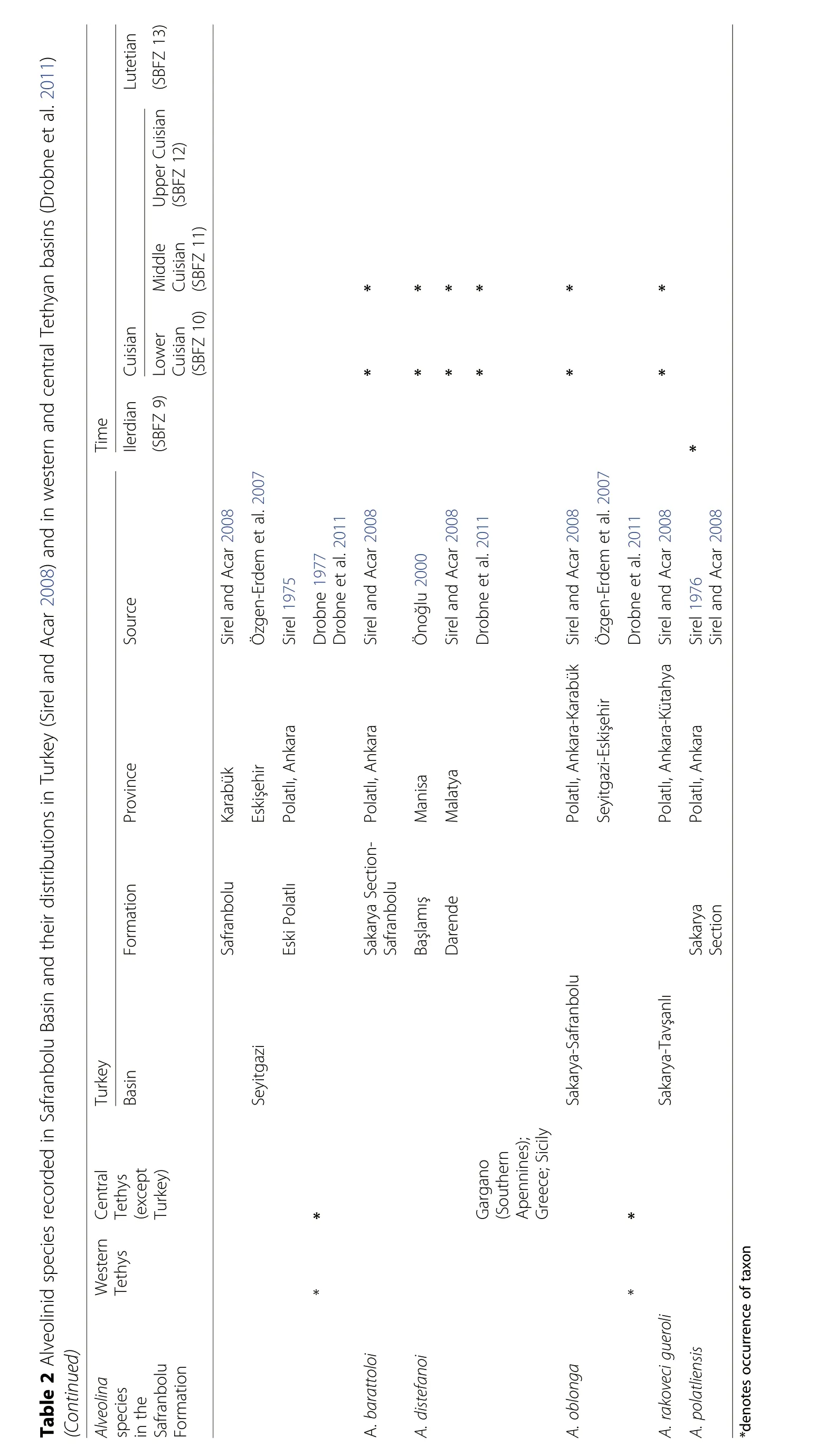
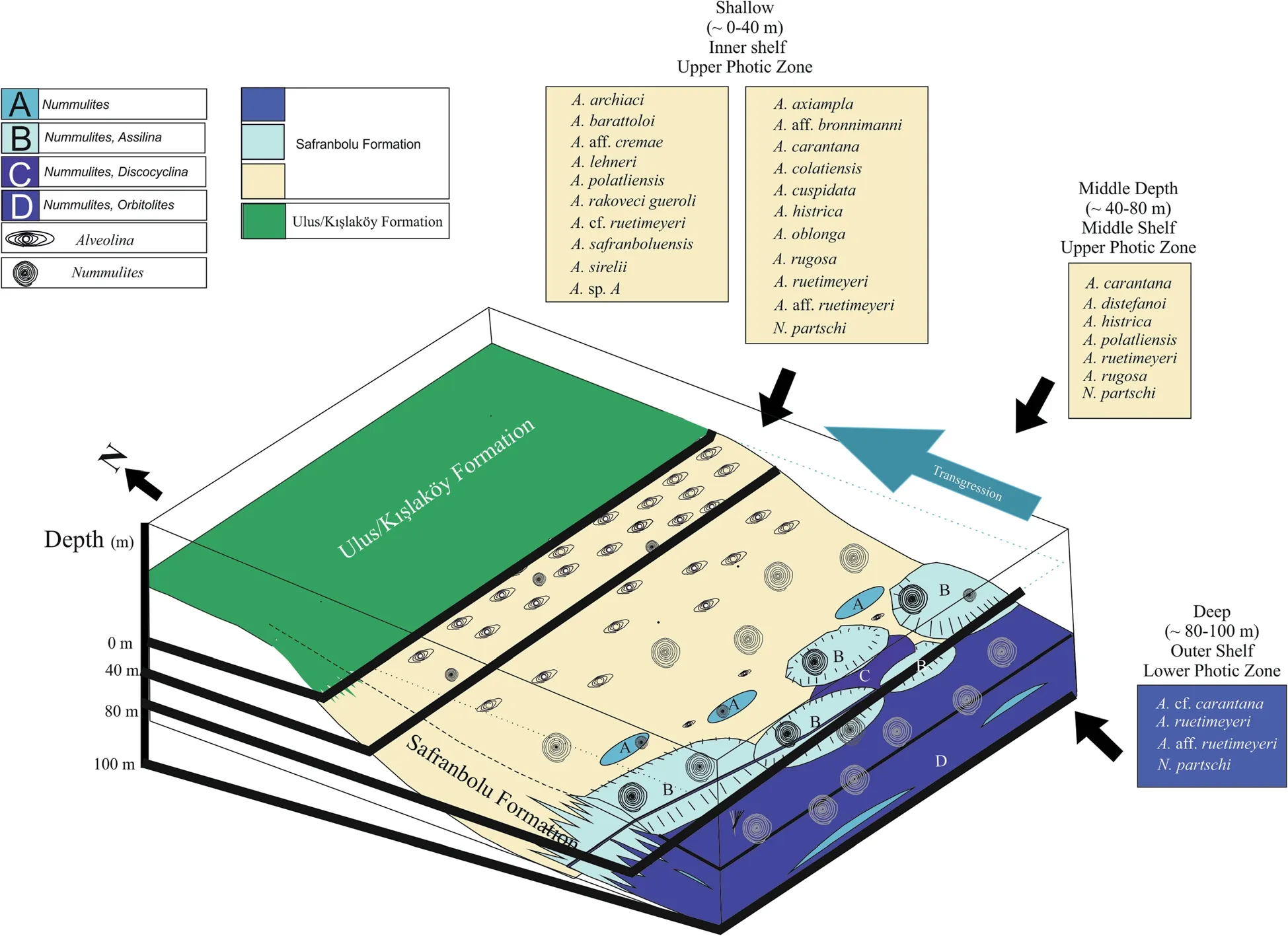
Fig.7 Block-diagram showing the spatial distribution of alveolinid species in the study area
Plate 1_5
(Slide No.: A1107–A1910; Sample No.: 11, 19)
1977 Alveolina carantana Drobne, Pavlovec &Drobne,p. 31, pl. 2, figs.1–7.
2000 Alveolina carantana Drobne,?no?lu, p. 270.
2011 Alveolina carantana Drobne, Drobne et al., p.728.
Remarks:Alveolina carantana and A. trempina are the same in the number of whorls and axial thicknesses.The former differs from the latter by its smaller elongation index and larger test size. The species has been reported from the eastern Alps and Adriatic region by Drobne et al. (1977) and Drobne et al. (2011). The two localities of A. carantana in Turkey are the Ba?lam?? Formation near Manisa recorded by ?no?lu (2000) and the Safranbolu Formation recorded by this study. The stratigraphic range of the species lies in the SBFZ 11–12 corresponding to the middle–late Cuisian age. A. carantana is recorded in the inner and middle–outer shelf areas, corresponding in upper and lower photic zones in the Safranbolu Basin.
Alveolina cf. carantanaDrobne, Pavlovec & Drobne 1977
Plate 1_6
(Slide No.: A0304; Sample No.: 3)
Remarks:Alveolina cf. carantana differs from A. carantana in having a smaller size, a smaller elongation index and the different growth stage.
Alveolina colatiensisDrobne, Pavlovec & Drobne 1977
Plate 1_7
(Slide No.: A1814; Sample No.: 18)
1977 Alveolina colatiensis Drobne, Pavlovec & Drobne,p. 72, pl.3, figs. 6–7.
Remarks:Alveolina colatiensis is similar to A. cremae in terms of the test size, however, it differs from the latter by its smaller proloculum and greater number of whorls. A. colatiensis has been described from the middle Cuisian sediments of the Adriatic Platform by Drobne et al. (1977) and from the Ba?lam?? Formation in Anatolia by ?no?lu (2000). The stratigraphic range of the species is the middle–upper Cuisian corresponding to the SBFZ 11–12. A. colatiensis is recorded from the sediments deposited in the inner shelf area of the Safranbolu Basin.
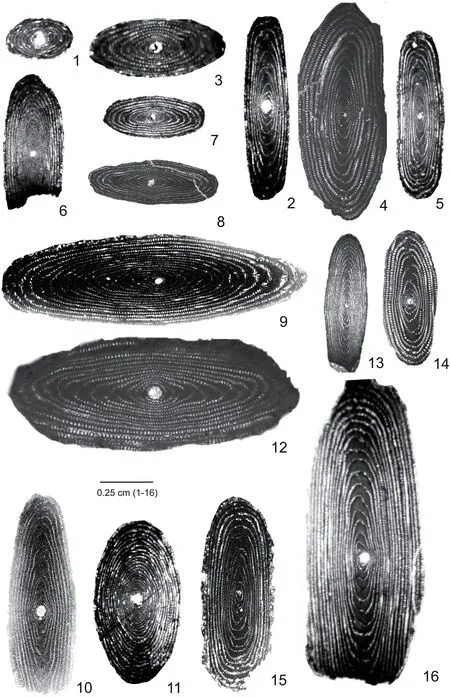
Plate 1 1 – Axial section, megalospheric form of Alveolina archiaci (Slide No.: A2102; Sample No.: 21); 2 – Alveolina axiampla (Slide No.: A1903;Sample No.: 19); 3 – Alveolina barattoloi (Slide No.: A2105; Sample No.: 21); 4 – Alveolina aff. bronnimanni (Slide No.: A1803; Sample No.: 18); 5 –Alveolina carantana (Slide No.: A1107–A1910; Sample No.: 11, 19); 6 – Alveolina cf. carantana (Slide No.: A0304; Sample No.: 3); 7 – Alveolina colatiensis(Slide No.: A1814;Sample No.: 18); 8 – Alveolina aff. cremae (Slide No.: A1807;Sample No.: 18); 9– Alveolina cuspidata(Slide No.: A1804–A2112; Sample No.: 18, 21); 10 – Alveolina distefanoi (Slide No.: A1114; Sample No.: 11); 11 – Alveolina sp. A (Slide No.: A2107; Sample No.: 21); 12– Alveolina histrica (Slide No.: A1108–A1502–A1803–A1905; Sample No.: 11, 15, 18, 19); 13 – Alveolina lehneri (Slide No.: A1809; Sample No.: 18); 14– Alveolina oblonga (Slide No.: A1812–A1912–A2113; Sample No.: 18, 19, 21); 15 – Alveolina polatliensis (Slide No.: A1103–A2118; Sample No.: 11,21);16–Alveolina rakoveci gueroli(Slide No.: A2119;Sample No.: 21).Scale bar is 0.25 cm for all
Alveolina aff. cremae
Plate 1_8
(Slide No.: A1807; Sample No.: 18)
Remarks:The specimen recorded in this study(Plate 1_8) has larger size and smaller elongation index than Alveolina cremae Checchia-Rispoli 1905. It has similar morphological characteristics with Alveolina aff.Cremae reported by Drobne et al. (1977). A. cremae was reported from the middle Cuisian (SBFZ 11) sediments by Drobne et al. (1977) and Sirel and Acar (2008), and also from SBFZ 11–12 of the ?ikola Canyon in North Dalmatian Basin by ?pani?ek et al. (2017).
Alveolina cuspidataDrobne 1977
Plate 1_9
(Slide No.: A1804–A2112; Sample No.: 18, 21)
1977 Alveolina (Alveolina) cuspidata Drobne, p. 54, pl.12, figs. 7–10.
1998 Alveolina cuspidata Drobne, ?zgen, p. 74, pl. 1,fig. 6.
2000 Alveolina cuspidata Drobne, ?no?lu, p. 271.
2011 Alveolina cuspidata Drobne, Drobne et al., p.749, pl.2.
Remarks:The order of whorls and the axial thickness are similar in both Alveolina cuspidata and A. lehneri.
A. cuspidata differs from the latter by its chamberlet size and a larger test size. A. cuspidata has been reported from the Adriatic Platform (Drobne et al. 2011), and the Ba?lam?? Formation (?no?lu 2000) and the Safranbolu Formation (?zgen 1998) in Anatolia. The stratigraphic range of the species corresponds to the upper Cuisian(SBFZ 12). A. cuspidata is found associated with several alveolinid species in the upper photic zone in shallowwater sediments of the Safranbolu Basin.
Alveolina distefanoiChecchia-Rispoli 1905
Plate 1_10
(Slide No.: A1114; Sample No.: 11)
1905 Alveolina distefanoi Checchia-Rispoli, p. 163, pl.12, fig. 9.
2008 Alveolina distefanoi Checchia-Rispoli, Sirel and Acar, p. 73, pl. 71, figs. 9–14.
2000 Alveolina distefanoi Drobne,?no?lu p. 271.
2011 Alveolina distefanoi Drobne, Drobne et al., p.728.
Remarks:Alveolina distefanoi has similar axial thickness and order of whorls with A. rugosa, but larger proloculum and test size.A.distefanoi is one of the alveolinid species that have a wide geographic distribution in the Tethyan region.It has been reported from northern Spain, eastern Alps, Adriatic Platform,northeastern Italy,southern Apennines,Greece and Sicily (Drobne et al. 2011). This species has also been recorded from the Ba?lam?? Formation by ?no?lu (2000)and from Darende-Malatya by Sirel and Acar(2008)in Anatolia.The stratigraphic range of the species is the lower–middle Cuisian corresponding to SBFZ 10–11, and is found in the middle shelf area in the Safranbolu Formation.
Alveolinasp. A
Plate 1_11
(Slide No.: A2107; Sample No.: 21)
Remarks:Alveolina sp. A resembles A. haymanensis Sirel 1976, however, the specimen recorded in this study possess more tightly coiled adult whorls, and larger size and elongation index than the latter. A. sp. A is found in the upper photic zone of the Safranbolu Basin.
Alveolina histricaDrobne 1977
Plate 1_12
(Slide No.: A1108–A1502–A1803–A1905; Sample No.:11, 15, 18, 19)
1977 Alveolina (Alveolina) histrica Drobne, p. 44, pl. 7,figs. 16–19; pl. 8, fig. 1.
2008 Alveolina histrica Drobne, Sirel and Acar, p. 74,pl. 57, fig. 7; pl. 58, fig. 4.
2011 Alveolina histrica Drobne, Drobne et al., p. 728.
2013 Alveolina histrica Drobne, ?zce et al., p. 196.
Remarks:Alveolina histrica and A.rakoveci are similar in the proloculum size and the order of their whorls;but A. histrica differs from the latter by having a more cylindrical test size. A. histrica has been reported from the Adriatic Platform (Drobne 1977; Drobne et al.2011), the Belendiz (Sirel and Acar 2008) and the ?ark??la-Sivas (?zce et al. 2013) in Anatolia, corresponding to the middle–upper Cuisian sediments of SBFZ 11–12. A. histrica is found in the inner shelf area of the Safranbolu Basin.
Alveolina lehneriHottinger 1960
Plate 1_13
(Slide No.: A1809; Sample No.: 18)
1960 Alveolina lehneri Hottinger, p. 147, pl. 13, figs.7–9.
1975 Alveolina lehneri Hottinger, Sirel, p. 190.
2007 Alveolina lehneri Hottinger, ?zgen-Erdem et al.,p. 924, pl. 9–e.
2008 Alveolina lehneri Hottinger, Sirel and Acar, p. 74,pl. 72, figs. 1–5.
2011 Alveolina lehneri Hottinger, Drobne et al., p. 249,pl. 2.
Remarks:Alveolina lehneri is most similar to A. ruetimeyeri in terms of its test size. However, it has smaller proloculum and chamberlets but larger number of whorls. A. lehneri has a wide geographic distribution in the sub-basins of the Tethys region from northern Spain to the Adriatic Platform and northern Italy (Drobne et al. 2011). The species has also been reported from various localities in Turkey, e.g., from Polatl? (Ankara)and ?amard? (Ni?de) by Sirel (1975) and Sirel and Acar(2008), from K??latepe (Seyitgazi-Eski?ehir) by ?zgen-Erdem et al. (2007). The stratigraphic range of this species corresponds to the middle–upper Cuisian sediments of SBFZ 11–12. A. lehneri is recorded in the upper photic zone in the Safranbolu Basin.
Alveolina oblongaD’Orbigny 1826
Plate 1_14
(Slide No.:A1812–A1912–A2113;Sample No.:18,19,21)
1826 Alveolina oblonga d’Orbigny, Tableau methodique, p. 306.
2001 Alveolina oblonga d’Orbigny, Drobne et al., p.749, pl.2.
2007 Alveolina oblonga d’Orbigny, ?zgen-Erdem et al., p.921, pl. 8–f.
2008 Alveolina oblonga d’Orbigny, Sirel and Acar, p.67, pl. 63, figs. 1–5; pl. 64, figs. 1–4.
Remarks:The test size and proloculum size are the same in both Alveolina oblonga and A. ruetimeyeri. The former species is distinguished from the latter by its different number of whorls in the growth stages. A. oblonga has a wide geographic distribution in the sub-basins of the Tethys region including northern Spain, southern France, the Adriatic Platform, northern Italy, Sicily and Eygpt (Drobne et al. 2011). The species has also been reported from various places in Turkey, such as Sakarya,Polatl?, Karabük (Sirel and Acar 2008) and Seyitgazi-Eski?ehir (?zgen-Erdem et al. 2007). The stratigraphic range of the species corresponds to the lower–middle Cuisian of SBFZ 10–11. A. oblonga is recorded in the shallow-water sediments of the Safranbolu Basin.
Alveolina polatliensisSirel 1976
Plate 1_15
(Slide No.: A1103–A2118; Sample No.: 11, 21)
1976 Alveolina polatliensis Sirel, p. 19, pl. II, figs. 1, 3,4, 6.
2008 Alveolina polatliensis Sirel, Sirel and Acar, p. 48,pl. 36, figs. 16–18;pl.37, figs. 1–3.
Remarks:The oval shaped test and small size of their chamberlets are similar in both Alveolina polatliensis and A. pieroi. A. polatliensis differs from A.pieroi by smaller axial thickness and possessing more whorls in the same test size. A. polatliensis was reported only from the Eski Polatl? Formation in Ankara by Sirel (1976), and was assigned to a middle Ilerdian age, corresponding to SBFZ 9 (Sirel and Acar 2008).This species here is found in the zones from SBFZ 9 extending to SBFZ 12 in this study. A. polatliensis is recorded in the upper photic zone close to the coast line in the Safranbolu Basin with several other alveolinid species.
Alveolina rakoveci gueroliDrobne 1977
Plate 1_16
(Slide No.: A2119; Sample No.: 21)
1977 Alveolina rakoveci gueroli, p. 46, pl. 8, figs. 6–8;pl. 9, figs. 1–5.
2008 Alveolina rakoveci gueroli Drobne, Sirel and Acar, p. 79, pl. 55, figs. 1, 2.
Remarks:The test size of Alveolina rakoveci gueroli,A. cayrazensis and A. lehneri are similar. A. rakoveci gueroli differs from the latter two species by greater axial thickness and chamberlets, and lesser number of whorls.A. rakoveci gueroli has been reported from the lower–middle Cuisian strata corresponding to the SBFZ 10–11 in the Tav?anl? Area (Kütahya, West Anatolia) by Sirel and Acar (2008). This species is recorded in the inner shelf area of the Safranbolu Basin. A. rakoveci has been reported from the Cuisian strata corresponding to the SBFZ 12 in the Adriatic Platform by Drobne et al. (1977)and Drobne et al. (2011). This species is recorded also in the inner shelf area of the Safranbolu Basin.
Alveolina ruetimeyeriHottinger 1960
Plate 2_1
(Slide No.: A0306–A1106–A1507–A2123; Sample No.:3, 11, 15, 21)
1960 Alveolina rütimeyeri Hottinger, p. 158, pl. 9, figs.17, 18; pl. 11, figs. 13–15; pl. 14, figs. 20–22; pl. 15, figs.5, 6.
1977 Alveolina ruetimeyeri Hottinger, Drobne, p. 64,pl. 17, figs. 2–5.
1999 Alveolina ruetimeyeri Hottinger, ?nan and ?nan,p. 125.
2002 Alveolina ruetimeyeri Hottinger, Karaba?o?lu et al., p.141.
2011 Alveolina ruetimeyeri Hottinger, Drobne et al., p.749, pl.2.
Remarks:The oval shape and small proloculum make Alveolina ruetimeyeri different from A. cremae. A. ruetimeyeri has a wide geographical distribution both in the Tethyan region and in Anatolia. It has been reported from Spain, France to the Adriatic Platform, northeastern Italy and Sicily (Drobne 1977; Drobne et al. 2011).Meanwhile, Toku? (?ark??la-Sivas) (?nan and ?nan 1999),Ba?lam?? (Manisa) (?no?lu 2000), Hank?y (Karaba?o?lu et al. 2002), Seyitgazi-Eski?ehir (?zgen-Erdem et al.2005), Safranbolu (Sirel and Acar 2008), and this study area are the locations in Anatolia where the species have been recognized. A. ruetimeyeri has a stratigraphic range of the lower–middle Cuisian corresponding to the SBFZ 10–11. It is recorded in the lower photic zone in the middle to outer shelf of the Safranbolu Basin.
Alveolina aff. ruetimeyeri
Plate 2_2
(Slide No.: A0305–A1907; Sample No.: 3, 19)
Remarks:Alveolina aff. Ruetimeyeri differs from A. cf.ruetimeyeri Hottinger 1960 by having larger size and elongation index. And, A. aff. Ruetimeyeri is recorded both in the lower and upper photic zone in the outer and inner shelf area of the Safranbolu Basin.
Alveolina cf. ruetimeyeriHottinger 1960
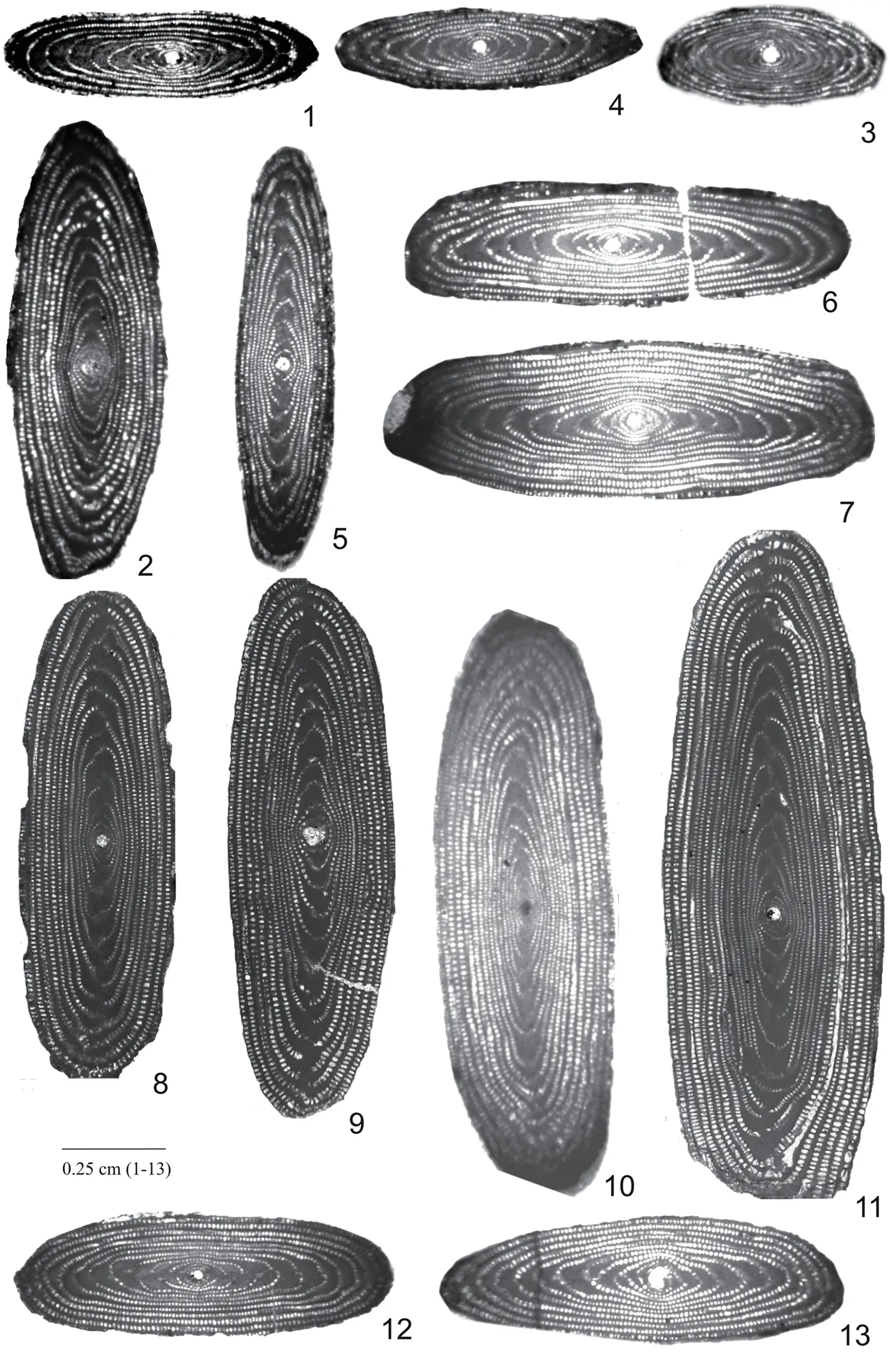
Plate 2 1 – Axial section, megalospheric form of Alveolina ruetimeyeri (Slide No.: A0306–A1106–A1507–A2123; Sample No.: 3, 11, 15, 21); 2 – Alveolina aff.ruetimeyeri(Slide No.:A0305–A1907;Sample No.:3,19);3–Alveolina cf.ruetimeyeri(Slide No.:A2118;Sample No.:21);4–Alveolina rugosa(Slide No.:A1112–A1813–A2111;Sample No.:11,18,21);5–13–Alveolina sirelii sp.nov.(Slide No.:A1508–A1814–A2125;Sample No.:15,18,21).Scale bar is 0.25 cm for all
Plate 2_3
(Slide No.: A2118; Sample No.: 21)
1960 Alveolina ruetimeyeri Hottinger, p. 158, pl. 9,figs. 17, 18; pl. 11, figs. 13–15; pl. 14, figs. 20–22; pl. 15,figs. 5, 6.
Remarks:The specimen recorded in this study has a similar proloculus with Alveolina ruetimeyeri, but possesses smaller axial and longer equatorial diameter. A. cf.ruetimeyeri is recorded in the inner shelf area of the Safranbolu Basin.
Alveolina rugosaHottinger 1960
Plate 2_4
(Slide No.:A1112–A1813–A2111;Sample No.:11,18,21)
1960 Alveolina rugosa Hottinger, p. 151, pl. 10, fig. 14;pl. 11, fig. 9; pl. 14, fig. 23.
1975 Alveolina rugosa Hottinger, Sirel, p.190.
1977 Alveolina rugosa Hottinger, Drobne, p. 54, pl. 12,figs. 12–14.
2008 Alveolina rugosa Hottinger, Sirel and Acar, p. 76,pl. 73, figs. 1–9.
2011 Alveolina rugosa Drobne, Drobne et al., p. 728.
Remarks:Alveolina rugosa is similar to A. ruetimeyeri in terms of the number of their whorls and axial thicknesses. A.rugosa is distinguished from the latter species by having more conical shape. A. rugosa has been reported from the Adriatic Platform and northeastern Italy (Drobne 1977;Drobne et al.2011),and,from Turkey(Ba?lam?? Formation(Manisa),?no?lu 2000;Polatl?(Ankara),Sirel 1975;?arlakdere and ?amard? (Ni?de) and Darende (Malatya),Sirel and Acar 2008).The stratigraphic range of the species is the lower–middle–upper Cuisian corresponding to the SBFZ 10–12. And the species is recorded in the middle shelf area of the Safranbolu basin.
Alveolina sirelii sp. nov.
Plate 2_5–Plate 2_13; Plate 3_1–Plate 3_2
(Slide No.:A1508–A1814–A2125;Sample No.:15,18,21)
Derivation of name:The species is dedicated to Dr.Ercüment Sirel who has substantial palaeontological contributions to larger foraminifera.
Holotype:Axial section of megalospheric form,Eski?ehir Osmangazi University,Micropalaeontology Laboratory.
Type locality:Sample Number: 15, 18 and 21, Safranbolu Formation, SE Safranbolu,northern Turkey.
Type level:Lower Cuisian (SBFZ 10).
Diagnosis:The medium-sized tests of megalospheric specimens have elongated forms with rounded poles.The axial diameter is 10.2–18.8 mm, equatorial diameter is 2.3–5.3 mm; the index of elongation is 3.2–3.4 in the fifth and 4.0–4.6 in the tenth whorl. The proloculus is large and spherical, with 0.3–0.4 mm in diameter,followed by one spherical–subspherical whorl in nepionic stage. In the following adult stage, the axial part of the basal layer becomes thicker as opposed to the basal layer of the equatorial spirals, and the whorl becomes elongated. The size of the chamberlets increases from the first to the last whorl.Their cross-sections are circular–subcircular in the early whorls,but become upright–oval at the last whorls. The description of the microspheric generation is based on one axial section. The microspheric form has elongated whorls of growth stage and the test shape is similar to megalospheric form. The large-sized test of microspheric form has an elongated shape.The axial diameter is 14.3 mm, and equatorial diameter is 4.3 mm. The index of elongation is 3.3 in the sixteenth whorl.
Remarks:Alveolina sirelii differs from A. cuspidata in its shape; the shape is elongated with rounded poles in the former, however, is fusiform in the latter. A. sirelii differs from A. histrica and A. rakoveci by size; the diameters of the latter species are both longer than 1 cm. A.sirelii has greater elongation index and smaller chamberlets than A.aff. Ruetimeyeri.
Distrubution:Alveolina sirelii has been recorded in the upper photic zone in the inner shelf area of the Safranbolu Basin, associated with abundant alveolinid species.
Alveolina safranboluensis sp. nov.
Plate 3_3–Plate 3_8
(Slide No.: A1816–A2112; Sample No.: 18, 21)
Derivation of name:Town Safranbolu where the samples were collected.
Holotype:Axial section of megalospheric form,Eski?ehir Osmangazi University,Micropalaeontology Laboratory.
Type locality:Sample Number: 18 and 21, Safranbolu Formation, SE Safranbolu, northern Turkey.
Type level:Lower Cuisian (SBFZ 10).
Description:The megalospheric generation of Alveolina safranboluensis has a middle sized, slightly elongated ovoid test with an axial diameter of 10.0–12.3 mm and equatorial diameter of 3.7–4.6 mm. The index of elongation is 2.3–3.5 in the fifth and 3.0–3.8 in the tenth whorl. The spheric proloculus, with 0.3–0.5 mm in diameter,is followed by two tightly coiled spheric whorls of the nepionic stage. The axial thickening becomes thicker in comparison with the basal layer of equatorial spirals in the following six or seven elongated whorls. In the last five to six adult whorls, the thickening of the basal layer becomes narrower at the axial as well as at the equatorial sectors. The cross-sections of the chamberlets are generally circular–subcircular, but become angular towards the outer whorls.
Remarks:Alveolina safranboluensis differs from A. sirelii with its larger proloculum, different juvenile stage,and smaller elongation index resulted from a thinner basal layer in its adult stage.
Distribution:Alveolina safranboluensis has been recorded in the upper photic zone in the inner shelf area of the Safranbolu Basin associated with abundant alveolinid species.
Family:Nummulitidae de BLAINVILLE, 1825
Subfamily:Nummulitinae de BLAINVILLE, 1825
Genus:Nummulites LAMARCK, 1801
Nummulites partschiDe la Harpe 1880
Plate 3_9–Plate 3_14
(Slide No.: N0204–N1002; Sample No.: 2, 10)
1880 Nummulites partschi, de la Harpe, pl. 3, figs. 1, 2,2a, 5, 5a, 6a.
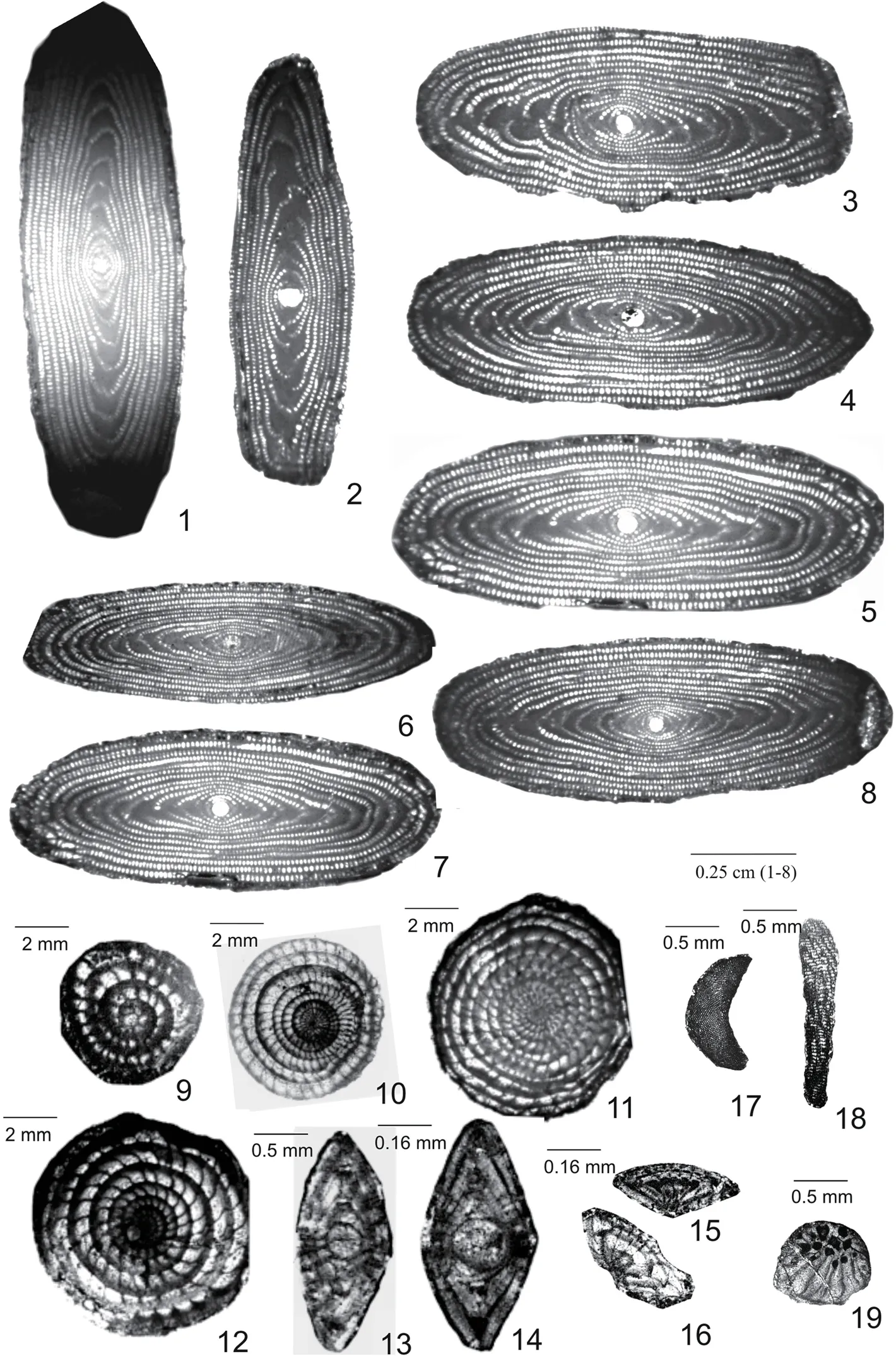
Plate 3 1–2 – Axial section, megalospheric form of Alveolina sirelii sp. nov. (Slide No.: A1508–A1814–A2125; Sample No.: 15, 18, 21); 3–8 –Alveolina safranboluensis sp. nov. (Slide No.: A1816–A2112; Sample No.: 18, 21); Scale bar is 0.25 cm for 1–8; 9 – Equatorial section, megalospheric form of Nummulites partschi (Slide No.: N0204; Sample No.: 2); 10–12 – Equatorial section, microspheric form of Nummulites spp. (Slide No.:N0702–N0901–N1201–N1401–N1602–N1901–N2101; Sample No.: 7, 9, 12, 14, 16, 19, 21); Scale bar is 2 mm for 9–12; 13 – Equatorial section,megalospheric form of Nummulites partschi(Slide No.: N1002;Sample No.:10); Scale bar is 0.5 mm; 14– Equatorial section,megalospheric form of Nummulites spp. (Slide No.: N1401–N1602–N1901–N2101; Sample No.: 14, 16, 19, 21); 15–16 – Equatorial section of Rotalia spp. (Slide No.: R1201–R1501–R1901–R2101; Sample No.: 12, 15, 19, 21); Scale bar is 0.16 mm for 14–16; 17 – Equatorial section of Discocylina spp. (Slide No.: D2101;Sample No.: 21); 18 – Equatorial section of Orbitolites spp. (Slide No.: O1201–O1601–O2101; Sample No.: 12, 16, 21); 19 – Equatorial section of Assilina spp. (Slide No.: S0701–S2101;Sample No.:7,21). Scale bar is 0.5 mm for 17–19
Remarks:Test diameter is 5.4 mm; proloculum is 0.5 mm consisting of 4 whorls. Rectangular chamberlets are separated by oblique septa. Specimes here are defined by their equatorial and axial sections of the macrospheric forms.
Nummulites spp.LAMARCK, 1801
Plate 3_10–12–Plate 3_14
(Slide No: N0702–N0901–N1201–N1401–N1602–N1901–N2101; Sample No: 7, 9, 12, 14, 16, 19, 21)
Remarks:Diameter of lenticular shells is 5–9 mm;microspheric forms consist of 7–8 whorls; rectangular chamberlets are separated by oblique septa. Size of chamberlets increases towards the last round.
Family:Rotaliidae EHRENBERG, 1839
Subfamily:Rotaliinae EHRENBERG, 1839
Genus:Rotalia LAMARCK, 1804
Rotalia spp.
Plate 3_15–Plate 3_16
(Slide No.: R1201–R1501–R1901–R2101; Sample No.:12, 15, 19, 21)
Remarks:The specimens have trochospiral coiling consisting of 4 whorls, with about 10 chamberlets in each whorl. The diameter of test size is 4 mm.
Family:Discocyclinidae GALLOWAY, 1928
Genus:Discocyclina GUMBEL, 1870
Discocyclina spp.
Plate 3_17
(Slide No.: D2101; Sample No.: 21)
Remarks:Disc-shaped test has a very tight planispiral coiling;and test diameter is 4.8 mm.
Family:Soritoidae EHRENBERG, 1839
Genus:Orbitolites LAMARCK, 1801
Orbitolites spp.
Plate 3_18
(Slide No.:O1201–O1601–O2101;Sample No.:12,16,21)
Remarks:Disc-shaped test has 6 whorls consisting of numerous small chamberlets.
Genus:Assilina D’ORBIGNY 1839
Assilina spp.
Plate 3_19
(Slide No.: S0701–S2101;Sample No.: 7, 21)
Remarks:Transverse section of the disc-shaped, flat,granular form of Assilina spp. is illustrated in Plate 3_19;diameter of the test is 3.45 mm.
4.2 Stratigraphical and palaeoenvironmental interpretations
The biostratigraphical, ecological and geographical distributions of the genus Alveolina from Turkey (Sirel 1998; Sirel and Acar 2008) and other localities (sub-basins) in the shallow zones of Tethyan margins (Spain,France, Italy, Greece, Libya, Egypt, Somalia, Tanzania,Iran, Iraq, Lebanon, Palestine, Pakistan, and the Persian Gulf) (Drobne et al. 2011) (Fig. 6a and b) were analyzed here in detail for the comparisons of the taxa found in the Safranbolu Formation. Many of the species recorded in the abovementioned areas were well-correlated with the taxa recorded in the study area.
Palaeontological analysis of the samples from the Safranbolu Formation yielded well-preserved benthic foraminifera belonging to the genera Alveolina, Nummulites, Assilina,Rotalia, Disclocyclina and Orbitolites. Among these, Alveolina is the most diversified genus which is represented by 16 species: Alveolina archiaci, A. axiampla, A. barattoloi,A. carantana, A. colatiensis, A. cuspidata, A. distefanoi, A.histrica, A. lehneri, A. oblonga, A. polatliensis, A. rakoveci,A. ruetimeyeri, A. rugosa, A. safranboluensis and A. sirelii.Comparisons of the alveolinid assemblage of the Safranbolu Formation with those assemblages previously reported from both Turkey(Fig.6a)and other Tethyan sub-basins(Fig.6b and c) revealed that Alveolina arciachi, A. barattoloi, A.polatliensis, A. safranboluensis, and A. sirelii have a restricted geographic distribution in Anatolia(Figs.5 and 6).
Four samples (Sample No.: 1, 4, 5, and 6) out of seven(Sample No.: 1–7), collected from the 9-m-thick top of the section, were barren of fossils. Only one sample(Sample No.: 3) yielded three alveolinid taxa: Alveolina ruetimeyeri, A. aff. Ruetimeyeri, and A. cf. carantana.
However, two samples (Sample No.: 2 and 7) at this interval yielded abundant Nummulites and Assilina species which are known as benthic foraminifera preferring environments deeper than ~80 m of sea, i.e. outer shelf areas. The presence of only a few alveolinid taxa beyond their shallow-depth habitats might have been due to their transportation along the shelf slope.
Similar to the first sample set (Sample No.: 1–7) on the top of the studied section, only one sample (Sample No.: 11) among six (Sample No.: 8–13) collected from the next 8-m-thick interval comprised alveolinid taxa.Alveolinid fossils in this interval of the section was more diverse and more abundant than the first sample set taken from the upper interval; but less diverse and less abundant than the 11-m-thick bottom section (Sample No.: 14–21). The recorded taxa were Alveolina archiaci,
A. carantana, A. distefanoi, A. histrica, A. polatliensis, A.ruetimeyeri, and A. rugosa. All of the assemblage, with the exception of only A. distefanoi, were also recorded in the bottom-interval. Alveolinids were accompanied by a few Nummulites, Orbitolites and Rotalia species in this zone.Diversity of the fossil content and its position in the section may denote a middle shelf setting, down to the depths of ~40–80 m in the upper photic zone(Fig.7).
Four samples(Sample No.:15,18,19 and 21)yielded the most abundant and diverse alveolinid species, including Alveolina archiaci, A. axiampla, A. barattoloi, A. carantana, A. colatiensis, A. cuspidata, A. histrica, A. lehneri, A.oblonga, A. polatliensis, A. rakoveci gueroli, A. ruetimeyeri,A.rugosa,A.rugosa,A.safranboluensis,A.sirelii and A.sp.A, collected from the 11-m-thick bottom-interval of the studied section. In addition to above species, Alveolina aff.Bronnimanni, A. aff. Cremae, A. aff. Ruetimeyeri and A. cf.ruetimeyeri were also recorded. The assemblage here was accompanied by only a few larger benthic taxa belonging to Nummulites, Assilina, Discocylina, Rotalia, Orbitolites, and Gastropoda(Table 1).
Recent alveolinids live down to a depth of about 60 m,and, the diversity and abundance of the fossil forms usually culminate at the depth down to ~40 m, in the shallowest part of shelves, in lagoonal or fore-reef settings(Hottinger 1960; Tosquella et al. 1990; ?zgen-Erdem 2008; Di Carlo et al. 2010; Drobne et al. 2011). Whereas other larger benthic foraminifera such as Nummulites,Assilina, Orbitoites are known inhabiting in environments deeper than ~80 m in the lower photic zone.Most of the studied section of the Safranbolu Formation is therefore, interpreted as a restricted platform of the basin in the upper photic zone based on the diversity and abundance of alveolinids and other larger benthic taxa (Fig. 7). These evidences reveal a transgressive sequence during the time interval of the deposition of SBFZ 10–12.
The stratigraphic distribution of alveolinid taxa reported from the shallow zones of the eastern, central and western Tethyan margins indicated a stratigraphic range from SBFZ 9 to SBFZ 13 for the Safranbolu Formation (Table 2; Fig. 6). Among 16 taxa recorded in the Safranbolu Formation, Alveolina polatliensis had the oldest stratigraphic record of the late Ilerdian age corresponding to the SBFZ 9, whereas A. axiampla developed in the upper Cuisian and the lower Lutetian corresponding to the SBFZ 12 and SBFZ 13. The stratigraphic distribution of the rest of alveolinids in the Safranbolu Formation culminated in the SBFZ 10–12, synchronous to a time interval of the Cuisian and particularly of the middle–late Cuisian age (Table 2). This interval appeared to be correlatable to the acme zone defined by Drobne et al. (2011) at the SBFZ 11–12 for the Adriatic Platform.
5 Conclusions
Twenty taxa belonging to the genus Alveolina along with the genera Nummulites, Assilina, Rotalia, Disclocyclina and Orbitolites were described from the Safranbolu Formation of the Cuisian age (SBFZ 10–12) in this study.Two alveolinid species, A. safranboluensis and A. sirelii,were newly described. Comparison of the spatial distributions of these alveolinid species with those reported from other sub-basins of the Tethyan realm revealed that most taxa have common occurrences in the entire region,except Alveolina archiaci,A.barattoloi and A.polatliensis;and, Alveolina archiaci, A. barattoloi, A. polatliensis together with the newly described species here were restricted only to Anatolia. The Safranbolu Basin also emerged as one of the most prolific sites comprising larger benthic foraminifera among the Eocene basins in Anatolia.Although the time range of the species recorded was from the late Ilerdian to the early Lutetian (SBFZ 9–13), the culmination occurred in the Cuisian in the zones of SBFZ 11–12. Ecological preferences of the fossil assemblage revealed that the Safranbolu Formation was deposited under transgressive conditions.
Acknowledgements
The authors wish to express their appreciation to Dr. Ercüment Sirel and Dr.Ali Deveciler from the Geology Department, Ankara University for their keen interest and sincere help during the course of the study. They have provided valuable support and constructive comments.
Authors’ contributions
Field work, sample collection, result interpretation, and concluding remarks were carried out by both KO and HK together. KO conducted the microscope study.The manuscript has been read and approved by both authors;and,there are no other persons who satisfied the criteria for authorship but are not listed.
Funding
This study was supported by and carried out under the Graduate Studies of Eski?ehir Osmangazi University, Council of Higher Education of Turkey.
Availability of data and materials
The manuscript is an outcome of a Master of Science Thesis submitted to the Graduate Studies of Eski?ehir Osmangazi University by the first author Kubra Okur who studied under the supervision of Dr. Hatice Kutluk.Specimens were collected from the study area during the field work and stored in the Micropaleontology Laboratory in the Department of Geology,Eski?ehir Osmangazi University.
Competing interests
The authors declare that they have no competing interests.
Received: 18 March 2019 Accepted: 8 January 2020

 Journal of Palaeogeography2020年1期
Journal of Palaeogeography2020年1期
- Journal of Palaeogeography的其它文章
- Liquefaction structures induced by the M5.7 earthquake on May 28,2018 in Songyuan,Jilin Province,NE China and research implication
- Ooidal ironstones in the Meso-Cenozoic sequences in western Siberia:assessment of formation processes and relationship with regional and global earth processes
- First steps in reconstructing Early Jurassic sea water temperatures in the Andean Basin of northern Chile based on stable isotope analyses of oyster and brachiopod shells
- Age of the earliest transgressive event in the Krishna-Godavari Basin,India:evidence from dinoflagellate cysts and planktonic foraminifera biostratigraphy
- The sedimentary dynamics of Sabellaria alveolata bioconstructions (Ostia,Tyrrhenian Sea,central Italy)
- A new early Visean coral assemblage from Azrou-Khenifra Basin,central Morocco and palaeobiogeographic implications
